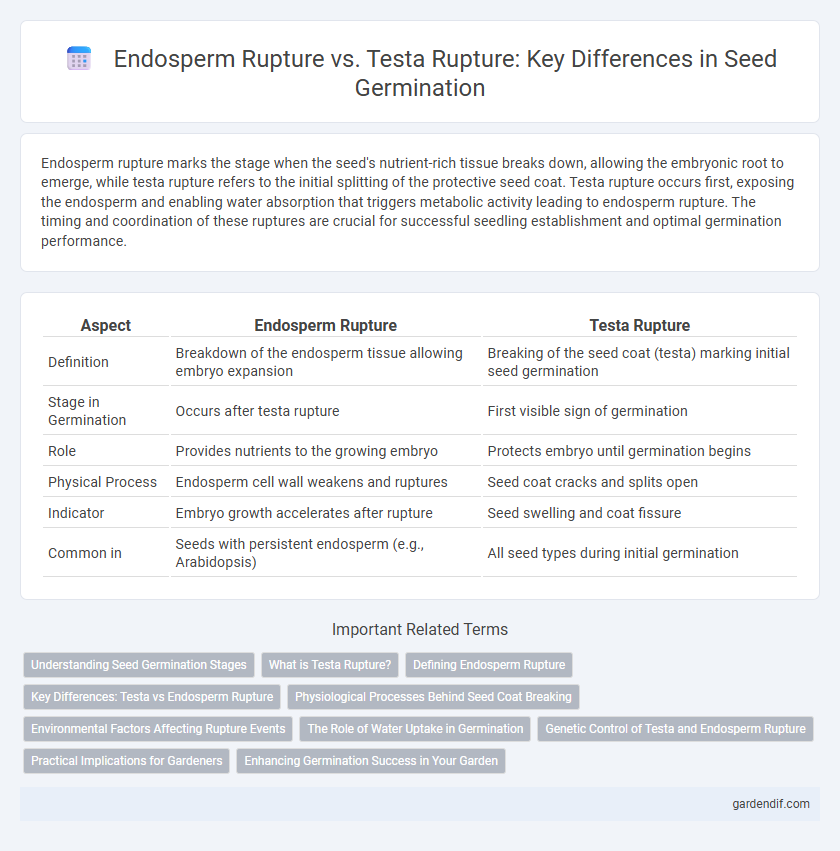
Endosperm rupture vs Testa rupture Illustration
Endosperm rupture marks the stage when the seed's nutrient-rich tissue breaks down, allowing the embryonic root to emerge, while testa rupture refers to the initial splitting of the protective seed coat. Testa rupture occurs first, exposing the endosperm and enabling water absorption that triggers metabolic activity leading to endosperm rupture. The timing and coordination of these ruptures are crucial for successful seedling establishment and optimal germination performance.
Table of Comparison
| Aspect | Endosperm Rupture | Testa Rupture |
|---|---|---|
| Definition | Breakdown of the endosperm tissue allowing embryo expansion | Breaking of the seed coat (testa) marking initial seed germination |
| Stage in Germination | Occurs after testa rupture | First visible sign of germination |
| Role | Provides nutrients to the growing embryo | Protects embryo until germination begins |
| Physical Process | Endosperm cell wall weakens and ruptures | Seed coat cracks and splits open |
| Indicator | Embryo growth accelerates after rupture | Seed swelling and coat fissure |
| Common in | Seeds with persistent endosperm (e.g., Arabidopsis) | All seed types during initial germination |
Understanding Seed Germination Stages
Endosperm rupture marks a critical phase in seed germination where the embryo emerges by breaking through the nutrient-rich endosperm layer, facilitating nutrient transfer to support seedling growth. Testa rupture occurs earlier, involving the breaking of the seed coat to allow water uptake and oxygen exchange essential for metabolic activation. These distinct stages highlight the sequential physical and physiological changes controlling successful seed germination and early seedling establishment.
What is Testa Rupture?
Testa rupture is the initial phase of seed germination where the seed coat, known as the testa, splits open allowing expansion of the embryonic structures inside. This rupture marks the transition from a dormant seed to active growth, facilitating the emergence of the radicle. Testa rupture is critical as it enables water uptake and gas exchange necessary for embryo development and subsequent endosperm rupture.
Defining Endosperm Rupture
Endosperm rupture is a critical phase in seed germination marked by the breakage of the endosperm layer, which surrounds the embryo and provides essential nutrients. This event follows testa rupture, where the seed coat cracks open, but unlike testa rupture, endosperm rupture signifies the embryo's active growth overcoming physical barriers. The timing of endosperm rupture is species-specific and influenced by environmental factors such as moisture and temperature, ultimately enabling radicle emergence and seedling development.
Key Differences: Testa vs Endosperm Rupture
Testa rupture marks the initial phase of seed germination where the seed coat breaks open, enabling water uptake and gas exchange, whereas endosperm rupture occurs later, signifying the breakdown of nutrient barriers to support embryo growth. The testa, primarily protective, differs structurally from the endosperm, which serves as a nutrient reservoir essential for seedling development. Endosperm rupture is a critical step that enables radicle emergence, while testa rupture ensures seed viability and protection during early hydration phases.
Physiological Processes Behind Seed Coat Breaking
Endosperm rupture precedes testa rupture during seed germination, marking critical physiological transitions where enzymatic activity increases to degrade endosperm cell walls, allowing embryo expansion. Seed coat breaking involves hormone-regulated weakening, primarily by gibberellins promoting cellulase and protease enzymes to digest structural barriers in the testa. This coordinated degradation facilitates water uptake and gas exchange, essential for embryo growth and successful seedling establishment.
Environmental Factors Affecting Rupture Events
Environmental factors such as temperature, moisture availability, and oxygen concentration critically influence both endosperm rupture and testa rupture during seed germination. Higher temperatures and optimal water levels accelerate enzymatic activities that weaken the testa, facilitating rupture, while hypoxic conditions can delay endosperm weakening and prolong the rupture process. Light quality and intensity also modulate hormone signaling pathways, affecting the timing and coordination of these sequential rupture events essential for successful seedling emergence.
The Role of Water Uptake in Germination
Water uptake triggers testa rupture by hydrating the seed coat, softening its structure to allow embryo expansion. Following testa rupture, continued water absorption targets the endosperm, weakening its cell walls to enable endosperm rupture and facilitate radicle emergence. The controlled sequence of water-driven testa and endosperm rupture ensures successful embryo growth during germination.
Genetic Control of Testa and Endosperm Rupture
Testa rupture and endosperm rupture during seed germination are tightly regulated by distinct genetic networks involving hormone signaling pathways, particularly gibberellins and abscisic acid. Genes such as GA3ox and ABA INSENSITIVE 5 (ABI5) modulate gibberellin synthesis and abscisic acid response, respectively, influencing the weakening and breakdown of the testa and endosperm layers. The genetic control mechanisms coordinate transcription factors and cell wall-modifying enzymes that facilitate mechanical barrier disruption to enable embryo expansion and seedling emergence.
Practical Implications for Gardeners
Endosperm rupture marks the seed's transition as the embryo growth pierces the nutrient reservoir, signaling the imminent emergence of the radicle, while testa rupture involves the breaking of the seed coat, allowing the seedling to access external moisture and oxygen. Gardeners monitoring testa rupture can anticipate initial germination stages, but observing endosperm rupture offers a more precise indicator of seedling vigor and successful nutrient mobilization. Understanding the timing between these ruptures helps optimize watering schedules and soil conditions, improving germination rates and early plant development.
Enhancing Germination Success in Your Garden
Endosperm rupture and testa rupture are critical phases in seed germination that influence water uptake and embryo expansion, directly impacting germination success in your garden. Endosperm rupture marks the weakening of nutrient tissue surrounding the embryo, while testa rupture refers to the breaking of the seed coat, allowing the radicle to emerge. Optimizing soil moisture and temperature conditions can facilitate timely endosperm and testa rupture, promoting vigorous seedling establishment and enhanced garden productivity.
Endosperm rupture vs Testa rupture Infographic

 gardendif.com
gardendif.com